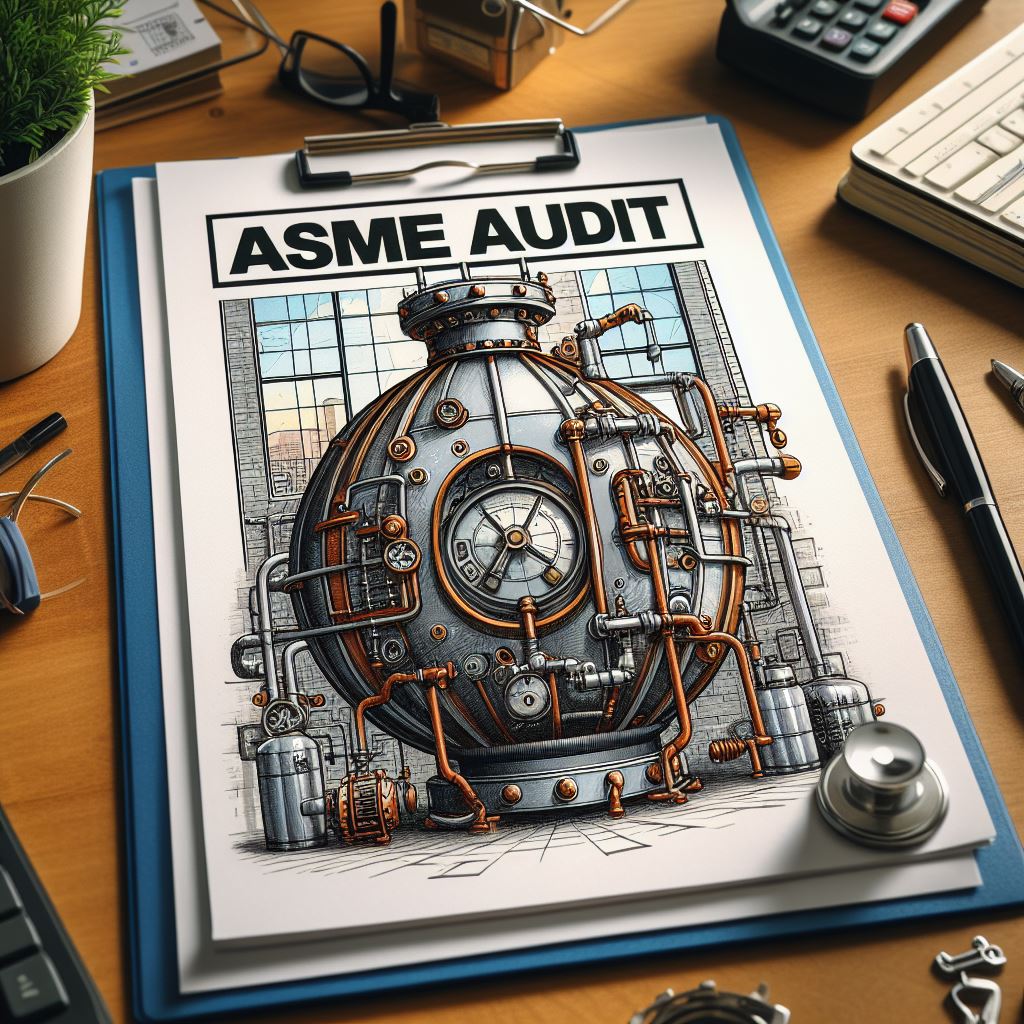
ASME calls it Conformity Assessment, not Audit. It is carried out jointly by ASME Team Leader and AIS & AI to fulfill the requirements of an ASME standard in order to advance public safety and facilitate international commerce.
Depending on activities being undertaken, the scope of Certification need to be clearly defined. Typically, a manufacturer of pressure vessel will start with certification scope of ‘U’ designator for ASME Sec VIII Div 1.
ASME CA-1 establishes the basis for assessment, with definitions and guidelines. ASME Sec II for Materials, ASME Sec V for NDT and ASME Sec IX for welding are must. Depending on type of vessel, ASME B16.5, B16.9, B16.11, B16.47, B16.20 etc. may be required.
As per the Mandatory Appendix 10 of ASME Sec. VIII Div 1, A written description of the system is required for code compliance. Depending upon the circumstances, the description may be brief or voluminous.
It is mandatory to have an Authorized Inspection Agency (AIA) on board. AIA will assign an Authorized Inspector (AI). The manufacturer shall explain the Quality Control System to AI for AI’s acceptance.
Knowledge of personnel involved in code activities is one of the important aspects of Audit. Depending on Function, examination / certificate of personnel qualification may be required. E.g. Design Engineers need to be qualified as per App-47 requirements.
A demonstration package is required to show the implementation of ASME Code requirements and Quality Control System. Typically, this can be done with a dummy project where live code vessels / items are not under manufacturing.
The Pre joint review is conducted by Inspection Agency under the lead of AIS with AI. This can be considered as a mock-up of Final Joint Review by ASME Team Leader. Pre joint review is generally scheduled 2 to 4 weeks before the final review. This time can be utilized to do the necessary corrections identified during pre joint review, if any. As the Pre joint review is almost the replica of final audit, the team gets a good idea of what to expect during the final audit and can do further preparations accordingly.
Typical Sequence of review activities (both Pre joint and Final review) are as follows:
Generally, the Team Leader along with AIS & AI conducts this review before reaching to workshop. The findings are shared to QA / QC department after opening meeting for their clarifications/corrections.
Typically on first day afternoon, Team leader will call for Opening meeting, with participation from all relevant functions. After formal introduction, the Team Leader will explain the review process. Team
Leader will also reconfirm the certification scope inline to the application. Team leader will explain the Due Process and Confidentiality policies for this review process. Team leader may request a shop tour for familiarization with products and processes. The overall review sequence will also be discussed and agreed.
Team leader will review each Function within the audit scope and access two things:
– Implementation of Code requirements and Quality Manual.
– Knowledge of the persons involved in the process.
If any question asked is not clearly understood, you can request the team leader to explain the question. Also, it will be appreciated if you can give the answer with a documentary support. Note that it is not an exam, but an evaluation. So, you don’t need to remember the answers. But you should know where to look for the answer (Code clause / Quality manual paragraphs / internal procedures etc). Note that it is not an exam. So, you don’t need to remember the answers. But you should know where to look for the answer (Code clause / Quality manual paragraphs / internal procedures etc).
While its not an exam, you have to also understand its not a training session. Don’t expect the team leader / AIS / AI to guide you. In case of any difficulties, you can ask for clarification but not for direct solutions.
Non-conformities are part of quality manual. Do not panic in case of any Non-conforming situations. Rather, Analyse if its actually an non-conformity. You are welcome to submit any additional evidence / clarifications for reconsideration.
Remain open for accepting NCRs. Look for available options to rectify the non-conformity ASAP. Agree on the corrective actions with AI and follow the NCR process to close the
same before the time of exit meeting. If in case the NCR can not be closed before exit meeting, you can still have 30 days time to close it. This is called follow-up. Typically, all efforts are made by the management to close the NCRs in time and avoid such situation.
Towards the end of Second day, the Team leader will take some time to discuss the observations internally with AI & AIS before calling for Exit Meeting. The Team Leader will share his observations, and will clearly inform his decision about recommendation to ASME. Team Leader will explain the observations and reason for his decision.
He will also explain the due-process again and ask if you agree to his observations and decision. If not, you can discuss further and in case of disagreement, you can make a written statement to ASME about your view point. However, if everything is in agreement, the observations report with recommendation is submitted to ASME by Team Leader. ASME will review the same and if found satisfactory, Certificate is issued for the requested scope.
 How to Conduct ASME Audit
How to Conduct ASME Audit Idealization in FEA
Idealization in FEA BASIC UNDERSTANDING OF FEA
BASIC UNDERSTANDING OF FEA WHAT IS A CODE STAMPED VS NON CODE STAMPED VESSEL?
WHAT IS A CODE STAMPED VS NON CODE STAMPED VESSEL?